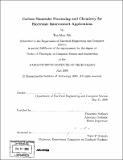Carbon nanotube processing and chemistry for electronic interconnect applications
Author(s)
Wu, Tan Mau, 1979-
DownloadFull printable version (53.73Mb)
Alternative title
Chemistry for electronic interconnect applications
Other Contributors
Massachusetts Institute of Technology. Dept. of Electrical Engineering and Computer Science.
Advisor
Francesco Stellacci.
Terms of use
Metadata
Show full item recordAbstract
Carbon nanotubes possess many properties that are ideally suited for electronic applications, such as metallic/semiconducting behavior and ballistic transport. Specifically, in light of mounting concerns over the increasing resistivity of the state-of-the-art interconnect material, copper, and the associated rise in interconnect power consumption and delay, carbon nanotubes are seen as a potential candidate for a future interconnect material. However, current integrated circuit manufacturing processes are ill-equipped to deal with discrete nanomaterials such as carbon nanotubes. In this thesis, several methods for the deposition and directed assembly of as-grown carbon nanotubes are examined. A metal/CNT-film structure is proposed as a relatively simple method to incorporate CNTs into an interconnect structure. Resistance comparisons between structures formed from films of Pd and randomly-aligned SWNTs and control Pd structures are highly variable, indicating that Pd/CNT processing techniques need significant refinement. However, comparisons between structures fabricated with films of randomly-aligned SWNTs and Pd control resistors show that randomly-aligned SWNT films are not competitive with pure metal structures, due to the low packing density and alignment inherent to these films. Finally, a covalent chemical CNT functionalization method to improve CNT handling without degradation in electronic conductivity is examined. SWNTs functionalized with this conductance-preserving carbene-CNT reaction, first reported by Lee et al [1], show resistance about an order of magnitude higher than unfunctionalized SWNTs but also an order of magnitude lower than SWNTs functionalized via a more typical covalent chemistry. In addition, evidence for controllable Fermi level shifting is seen for carbene-functionalized SWNTs, with shifts of up to 100 mV observed, and varying depending on the extent of functionalization and type of carbene group used.
Description
Thesis (Ph. D.)--Massachusetts Institute of Technology, Dept. of Electrical Engineering and Computer Science, 2008. Includes bibliographical references (p. 215-221).
Date issued
2008Department
Massachusetts Institute of Technology. Department of Electrical Engineering and Computer SciencePublisher
Massachusetts Institute of Technology
Keywords
Electrical Engineering and Computer Science.